- Another round of US stimulus remains in stalemate
- Cyclical rotation reverses back to favor tech
- Biden will keep tariffs on China for now
Key Events
Futures on the Dow, S&P, NASDAQ and Russell 2000 are all lower ahead of Wednesday's US open as traders weigh a potential no-deal Brexit, the ongoing impasse in the US on fiscal aid and President-elect Joseph Biden’s lack of clarity on Chinese tariffs—while the more significant themes of the worst pandemic in a century and vaccine progress loom in the background.
Though slightly higher, the dollar remains under pressure and gold has recovered slightly.
Global Financial Affairs
Although all four major US contracts were in the red, NASDAQ futures only edged into negative territory, illustrating another reversal in the cyclical rotation.
The negative investor sentiment followed Senate Majority Leader Mitch McConnell shooting down another bipartisan $908 billion stimulus plan. The move followed months of Congressional inaction and was a turnaround for the Kentucky Republican who had shown his support for a $500 billion plan in October.
McConnell now wants a “targeted relief bill.” He also stressed that Congress must approve funding legislation before the Dec.11 deadline to avoid a government shutdown.
S&P 500 futures struggled against completing a rising flag.

The index was bearish after dropping nearly a full percent since Tuesday’s highs. Should the price break the downside of the flag it would signal another leg down in the selloff.
In Europe, the same reversal out of value sectors, including banks and carmakers, back into stocks that perform better when the economy is halted amid social restrictions, led the Stoxx 600 Index in a selloff.
The British pound nearly wiped out Tuesday’s gains after European Union chief Brexit negotiator, Michel Barnier was reported to have told EU ambassadors that they may fail to strike a deal before the UK leaves the bloc.
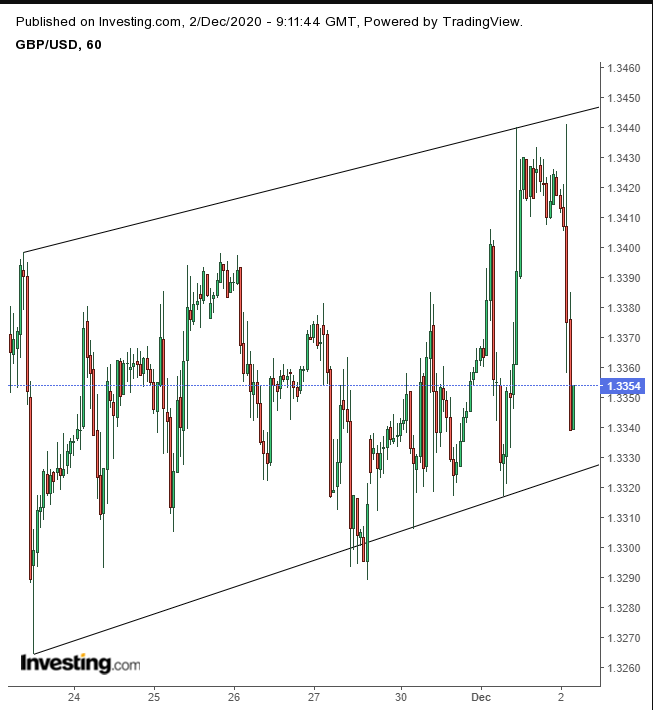
While the pound dropped significantly, it found demand again after nearing the bottom of an hourly rising channel since Nov. 23, providing risk-takers an opportunity for long position to retest the channel top again.
Asia was mostly flat, with South Korea’s KOSPI, up 1.6%, far outperforming regional peers, hitting all-time highs on optimism that US stimulus would help the economic recovery and on positive sentiment in the tech sector. About half of foreign purchases flowed into tech shares on expectations for positive earnings among chipmakers.
China’s Shanghai Composite dropped 0.1%, erasing earlier gains, after losses for healthcare shares erased gains by property stocks. The news that factory activity posted the fastest expansion in a decade in November failed to stimulate demand.
Shares in the country’s second-largest smartphone manufacturer Xiaomi (OTC:XIACF) suffered the worst loss in the company's history after it announced it had completed a $3.1 billion convertible bond placing.
The Chinese yuan gave up an advance after Biden told the New York Times he’s keeping President Donald Trump’s tariffs in place for now.
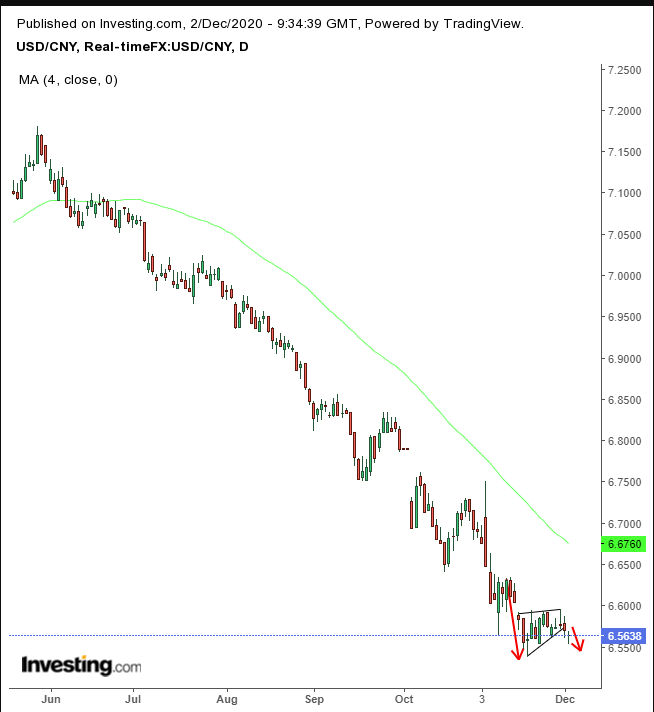
Nevertheless, the weakened dollar completed a rising flag versus the renminbi, bearish after the near-1,000-point drop within the five sessions preceding the pause. The pattern signals a continued downtrend, as shown by the 50 DMA.
American equities notched another record on Tuesday as Congress returned from vacation, building on the bullish mood set by COVID-19 vaccine progress. There was even talk of a federal spending plan as the President-elect called on US policy makers to approve aid.
Yields, including on the 10-year Treasury note, struggled to hold on to Tuesday’s gains, as investors stopped buying Treasuries. Still they didn't sell either, amid the decline in stock futures and European stocks ahead of the US open.
The dollar recouped what would have been a second day of losses, but it was unable to make new ground, keeping the greenback at its lowest level since April 2018.
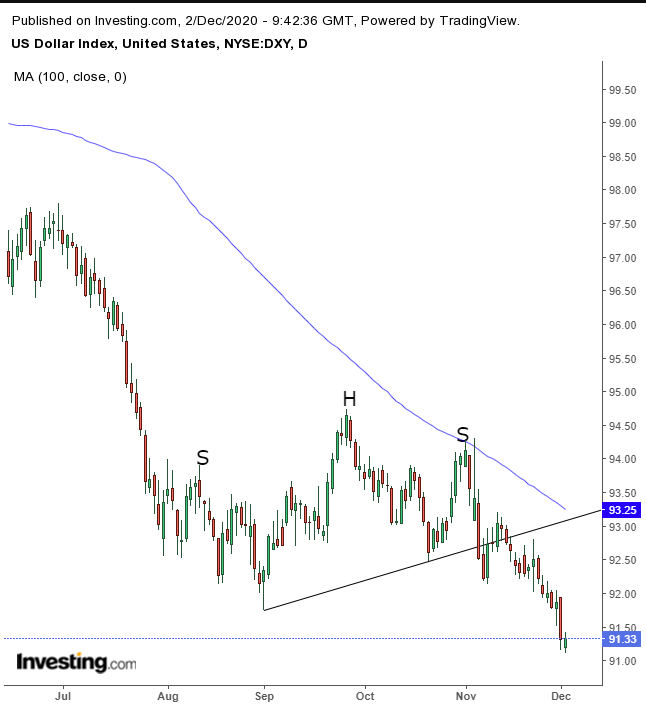
The hope for stimulus created the prospect of a devalued currency; the failure of talks had traders rushing to buy what was now considered a too cheap dollar.
Gold finally reclaimed its haven status, crossing back over the 200 DMA, and re-entering the declining range since its Aug. 7 all-time high.
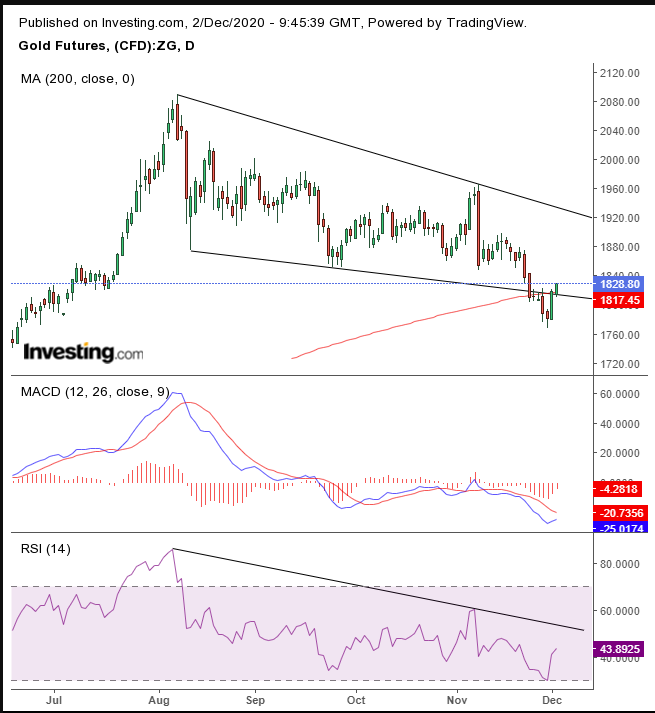
The RSI is bouncing off its lows, aiming at its downtrend line and the MACD’s short MA is curving upward toward the long MA. Will gold surprise us again? Technically, it could certainly retest the pattern top above $1,900.
Bitcoin has been fluctuating wildly after falling away from its new record close of $19,892, though it failed to notch an all-time high at the $20,000 milepost.
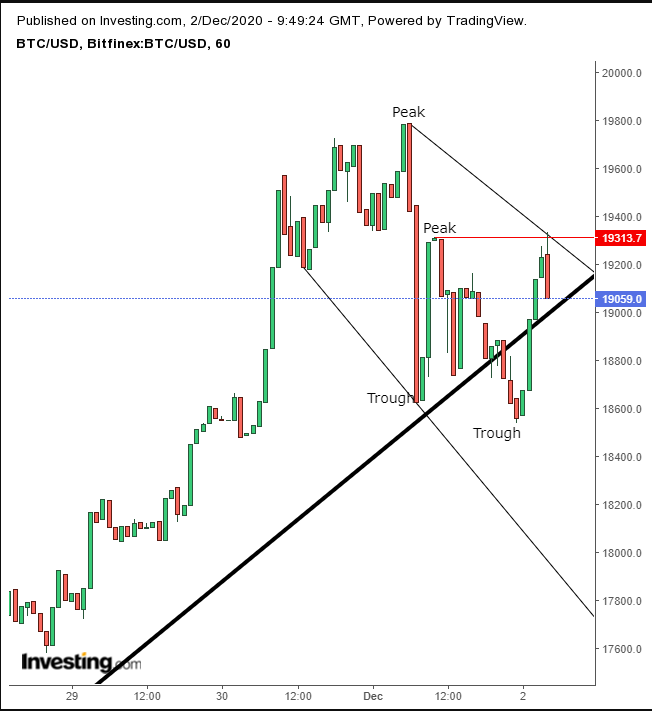
The cryptocurrency is struggling between the long-term uptrend and a short-term downtrend, giving aggressive traders a short opportunity, along the framework of a falling channel.
Oil rebounded from a third-day decline amid tensions between OPEC+ members on the cartel’s continued production amid an uneven economic recovery between faster growing Asia and the lagging US and Europe.
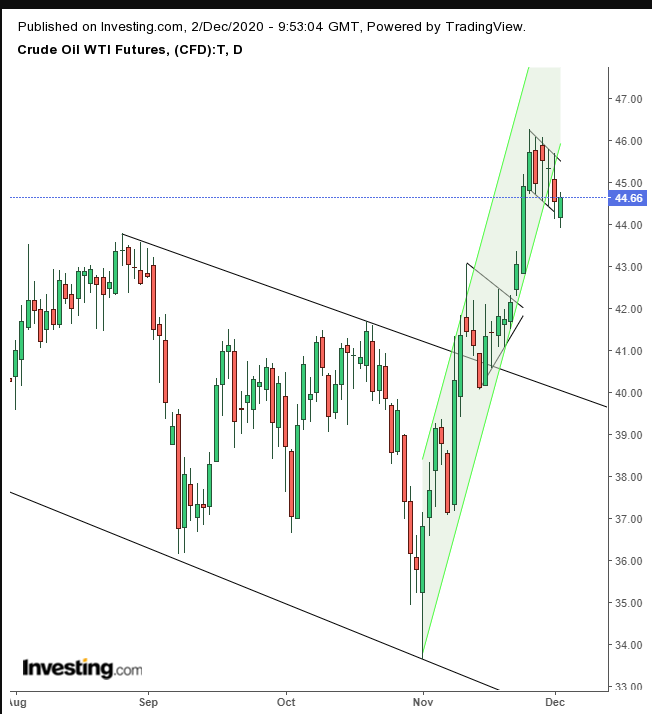
The rebound was a struggle to remain within a falling flag, bullish—with an upside breakout—after the preceding near-10% surge in just three sessions.
Up Ahead
- Today the Chairman of the Federal Reserve, Jerome Powell testifies before Congress for the second day.
- The US employment report on Friday is expected to show more Americans headed back to work in November, though at a slower pace than October.
Market Moves
Stocks
- The Stoxx Europe 600 Index declined 0.3%.
- NASDAQ 100 Index futures were little changed.
- Futures on the S&P 500 Index decreased 0.2%.
- The MSCI Asia Pacific Index increased 0.2%.
Currencies
- The Dollar Index was flat at 92.34.
- The British pound decreased 0.4% to $1.337.
- The Japanese yen weakened 0.2% to 104.57 per dollar.
- The offshore yuan weakened 0.1% to 6.5596 per dollar.
Bonds
- Germany’s 10-year yield climbed less than one basis point to -0.53%.
- Britain’s 10-year yield dipped one basis point to 0.341%.
- France’s 10-year yield rose less than one basis point to -0.288%.
- Japan’s 10-year yield gained one basis point to 0.026%.
